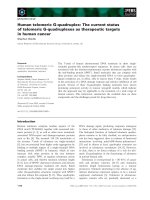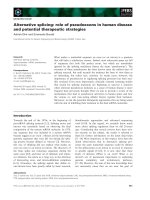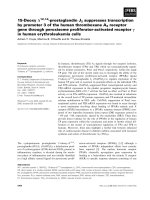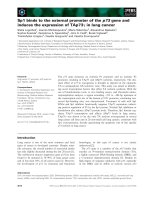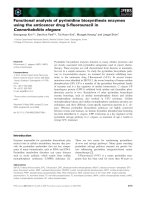Studies of the anticancer potential of andrographolide in human cancer cells
Bạn đang xem bản rút gọn của tài liệu. Xem và tải ngay bản đầy đủ của tài liệu tại đây (2.64 MB, 201 trang )
STUDIES OF THE ANTICANCER POTENTIAL OF
ANDROGRAPHOLIDE IN HUMAN CANCER CELLS
ZHOU JING
(M. Med. China Academy of Chinese Medical Sciences; P. R. China)
A THESIS SUBMITTED FOR
THE DEGREE OF DOCTOR OF PHILOSOPHY
DEPARTMENT OF EPIDEMIOLOGY AND PUBLIC HEALTH
NATIONAL UNIVERSITY OF SINGAPORE
2009
ii
ACKNOWLEDGEMENTS
I would like to express my deepest respect and acknowledgements to my
supervisor, Prof. Shen Han-Ming, for his professional and enthusiastic guidance, as
well as the encouragement, patience and instructive discussions throughout my study.
I also would like to gratefully acknowledge Prof. Ong Choon-Nam for his consistent
support and constructive suggestions on my study. Their guidance not only introduced
me into this exciting biological area, but also taught me the right way of doing
scientific research. What I have learned from them will benefit my future career and
life.
It was also a great pleasure for me to study in such a warm and harmonious family
of Department of Epidemiology and Public Health. I was surrounded by a group of
friendly people who helped me carrying out my study smoothly. I would like to thank
Prof. David Koh for his general guidance and support during my study in this
department. A special thank goes to our laboratory staff: Mr. Ong Her Yam, Mr. Ong
Yeong Bing, Ms. Zhao Min and Ms. Su Jin for their technical support and kind help in
the process of laboratory work. I also would like to extend my appreciation to my
bench mates Dr. Zhang Siyuan, Dr. Won Yen Kim, Dr. Huang Qing, Dr. Shi Ranxin,
Ms. Ong Chye Sun, Mr. Wu Youtong, Ms. Tan Huiling, Ms Shi Jie, Ms Zhuang Qiushi,
Mr. Zhao Wei and Ms. Ng Shukie for their useful comments and suggestions on my
study. I would also like to thank all other staff and graduate students in our
department, for their generous help and encouragement.
Especially, I would like to express my deepest appreciation to my husband, my
parents and dear sister, for their love, understanding and continuing support.
iii
TABLE OF CONTENTS
Title Page
Acknowledgements ii
Table of Contents iii
Summary ix
List of Tables and Figures xi
Abbreviations
xiii
List of Publications
xvii
CHAPTER 1
INTRODUCTION
1.1 Andrographolide (Andro) 2
1.1.1 Andrographis paniculata and Andro 2
1.1.2 Chemical structure and metabolism of Andro 2
1.1.3 Pharmacological properties of Andro 4
1.1.3.1 Inhibitory effects on inflammation 4
1.1.3.2 Immuno-regulatory effects 6
1.1.3.3 Anti-HIV effects 7
1.1.3.4 Hepatoprotective effects 8
1.1.3.5 Cardiovascular protective effect 8
1.1.3.6 Anti-diabetes effects 9
1.1.3.7 Anticancer potential of Andro 10
1.1.3.7.1 Inhibition of cancer cell proliferation and induction of cell cycle
arrest 10
1.1.3.7.2 Induction of apoptotic cell death 11
iv
1.1.3.7.3 Anti-angiogenesis, anti-adhesion and other effects 12
1.1.4 Molecular mechanisms involved in the effects of Andro 12
1.1.4.1 Effect on NF-κB signaling pathway 12
1.1.4.2 Effects on Mitogen-activated protein kinase (MAPK) pathway 14
1.1.4.3 Effects on AKT/PKB survival pathways 15
1.2 Apoptosis and Apoptosis regulation 17
1.2.1 General introduction about apoptosis 17
1.2.2 Caspases 21
1.2.3 Bcl-2 protein family and mitochondria 22
1.2.3.1 Bcl-2 protein family 22
1.2.3.2 The central role of mitochondria in apoptosis process 24
1.2.3.3 Mechanisms of Bcl-2 proteins regulating apoptosis at mitochondrial
level 26
1.2.4 p53 29
1.2.4.1 Regulation of p53 expression and function in apoptosis 29
1.2.4.2 Role of p53 in apoptosis 31
1.2.5 Reactive Oxygen Species (ROS) 33
1.2.5.1 ROS and ROS-activated molecules 33
1.2.5.2 Involvement of ROS in apoptosis 35
1.2.6 STATs signaling pathway 38
1.2.6.1 STAT family members and their functional domains 38
1.2.6.2 Activation of STATs signaling 39
1.2.6.3 Negative regulation of STATs signaling 40
1.2.6.4 STAT3 as an oncogene in cancer therapy 42
1.2.7 Dys-regulated apoptosis in cancer 44
v
1.2.8 TRAIL and TRAIL-induced apoptosis 45
1.2.8.1 Introduction 45
1.2.8.2 Regulation of TRAIL-induced cell death 46
1.3 Objectives of the study 49
CHAPTER 2
THE CRITICAL ROLE OF PRO-APOPTOTIC BCL-2 FAMILY MEMBERS
IN ANDRO-INDUCED APOPTOSIS IN HUMAN CANCER CELLS
2.1 Introduction 52
2.2 Materials and Methods 54
2.2.1 Chemicals and reagents 54
2.2.2 Cell culture and treatments 54
2.2.3 Detection of Apoptosis 55
2.2.4 Caspase 3/7 activity assay 55
2.2.5 Cell subfractionation 56
2.2.6 Immunoprecipitation and western blot 56
2.2.7 Transient transfection and siRNA-mediated protein knock-down 57
2.2.8 Immunofluorescence and confocal microscopy 57
2.2.9 Statistical analysis
58
2.3 Results 58
2.3.1 Andro induces apoptosis in human cancer cells 58
2.3.2 Caspase cascade in Andro-induced apoptosis
59
2.3.3 Andro induces Bid cleavage following caspase-8 activation 64
2.3.4 Andro induces Bax conformational change
64
2.3.5 Andro induces Bax translocation and cytochrome c release 65
2.3.6 Knockdown of Bid expression protects cell from Andro-induced cell death
65
vi
2.3.7 Bcl-2 and CrmA over-expression block Andro-induced apoptosis 70
2.4 Discussion 72
CHAPTER 3
ANDRO SENSITIZES CANCER CELLS TO TRAIL-INDUCED APOPTOSIS
VIA P53-MEDIATED DEATH RECEPTOR 4 UP-REGULATION
3.1 Introduction 78
3.2 Materials and Methods 79
3.2.1 Chemicals, reagents and antibodies 79
3.2.2 Cell culture and treatments 80
3.2.3 Detection of apoptosis 80
3.2.4 RNA interference 80
3.2.5 Immunoblot analysis 81
3.2.6 Measurement of intracellular ROS 81
3.2.7 Measurement of cell surface expression of death receptors 81
3.2.8 RNA extraction and reverse transcription-PCR 81
3.3 Results 82
3.3.1 Andro sensitizes TRAIL-induced apoptosis
82
3.3.2 Andro promotes TRAIL-induced caspase activation 85
3.3.3 Andro promotes FLIP-L cleavage and XIAP down-regulation as a result of
enhanced caspase activation
88
3.3.4 Andro sensitizes TRAIL-induced apoptosis via DR4 up-regulation 91
3.3.5 DR4 up-regulation is critical for the sensitization effect of Andro 91
3.3.6 p53 is required for the DR4 up-regulation and enhanced apoptosis induced
by Andro 94
3.3.7 Andro elevates p53 expression through JNK-mediated p53 Thr81
vii
phosphorylation 99
3.4 Discussion 104
CHAPTER 4
INHIBITION OF CONSTITUTIVE STAT3 ACTIVITY BY ANDRO
ENHANCES CHEMO-SENSITIVITY OF CANCER CELLS TO
DOXORUBICIN
4.1 Introduction
110
4.2 Materials and Methods
112
4.2.1 Cell culture and reagents 112
4.2.2 Luciferase assay 112
4.2.3 Preparation of nuclear and cytosolic extracts 113
4.2.4 Immunofluorescence and confocal microscopy 113
4.2.5 DNA transfection and immunoprecipitation 114
4.2.6 Colony formation assay 114
4.3 Results 114
4.3.1 Andro suppresses constitutive STAT3 activation in human cancer cells 114
4.3.2 Andro inhibits IL-6-inducible STAT3 phosphorylation and nuclear
translocation in human cancer cells 117
4.3.3 Andro inhibits STAT phosphorylation through JAK1/2 suppression 120
4.3.4 Constitutively active STAT3 confers resistance to doxorubicin-induced
cytotoxicity in cancer cells 123
4.3.5 Andro enhances doxorubicin-induced apoptosis in human cancer cells 127
4.3.6 Andro sensitizes doxorubicin-induced apoptosis via suppression of STAT3 131
4.4 Discussion 134
viii
CHAPTER 5
GENERAL DISCUSSION AND CONCLUSIONS
5.1 Pro-apoptotic Bcl-2 members play a critical role in Andro-induced
apoptosis 141
5.2 Andro sensitizes TRAIL-induced apoptosis in human cancer cells 144
5.3 Andro inhibits STAT3 activation and sensitizes doxorubicin-induced cell
death in human cancer cells 149
5.4 The interlinks among molecular mechanisms involved in Andro anticancer
property 152
5.5 Conclusions 153
CHAPTER 6
REFERENCES
References 156
ix
SUMMARY
Andrographolide (Andro) is one of the major active components in Andrographis
paniculata, a traditional herbal medicine which has been widely used in treatment of
various disorders including respiratory infection, bacterial dysentery, diarrhea, and
fever. Andro, a bicyclic diterpenoid lactone, has been shown to possess potent anti-
inflammatory effect, which is executed by inhibiting NF-κB pathway and regulating
expression of various cytokines. Recently, Andro was proposed to be able to induce
apoptosis in cancer cells, suggesting the anticancer potential of this compound.
However, the molecular mechanisms are largely unknown. Therefore, in order to
systematically investigate the anticancer properties of Andro, the following
investigations have been conducted in this study: (i) identification of the molecular
mechanisms involved in Andro-induced apoptosis; (ii) evaluation of the anti-tumor
potential of Andro by investigating its sensitization ability on TRAIL-induced
apoptosis; (iii) investigation of the combined effect of Andro with an established
cancer theratpeutic agent doxorubicin in cancer cells.
First, I found that Andro could induce caspase-dependent apoptosis in various
human cancer cells. To elucidate the mechanisms of Andro-induced apoptosis, a series
of experiments were conducted to demonstrate the critical role of pro-apoptotic Bcl-2
proteins (Bid and Bax) in relaying the cell death signaling initiated by Andro from
caspase-8 to mitochondria, leading to the release of cytochrome c and activation of
caspase cascade, and eventually resulting in apoptotic cell death in cancer cells.
Next I investigated the anticancer potential by evaluating the synergistic effect of
Andro on TRAIL-induced apoptosis. Andro significantly sensitized various cancer
cells in response to TRAIL-mediated apoptosis. Such sensitization was achieved
x
through the up-regulation of DR4. Furthermore, p53 protein which was stabilized and
activated by ROS-mediated JNK phosphorylation, was found to be responsible for the
DR4 up-regulation and Andro-sensitized apoptosis in cancer cells.
In addition to the sensitization effect of Andro and TRAIL, I also investigated the
synergistic effect of Andro on the anticancer activities of doxorubicin, a potent
chemotherapeutic agent that has been widely used in cancer therapy. Our data
demonstrated that the sensitization effect was due to Andro-mediated inhibition on
STAT3 activity. As a result, Andro caused the suppression of STAT3-mediated
transcription of anti-apoptotic genes (Bcl-2 and Mcl-1), which contributed to the
enhanced sensitivity of cancer cells in response to doxorubicin.
In conclusion, the present study provides a new insight of the anticancer property
of Andro. Andro could be used alone as an anticancer agent through inducing
apoptosis in various cancer cells. More importantly, this study provides convincing
evidence showing that Andro is capable of sensitizing cancer cells to TRAIL and
doxorubicin-induced apoptosis. Such findings support the potential application of
Andro as a potent apoptosis inducer and chemo-sensitizer in cancer therapy.
xi
LIST OF TABLES
Table 1.1 Bcl-2 family members 24
Table 1.2 Activated STAT transcription factors in tumor types 42
LIST OF FIGURES
Figure 1.1 Andrographis paniculata and chemical structure of Andro 3
Figure 1.2 Scheme depicting intrinsic and extrinsic pathways of apoptosis 20
Figure 1.3 STAT3 signaling regulation 40
Figure 2.1 Andro induces apoptosis in human cancer cell lines 60
Figure 2.2 Andro shows no cytotoxicity in MEF cells 61
Figure 2.3 Andro promotes caspase activation 62
Figure 2.4 Andro induced caspase-dependent apoptosis 63
Figure 2.5 Andro-induced Bid cleavage following caspase-8 activation in
HepG2 cells 66
Figure 2.6 Bax conformational change following caspase-8 activation in
HepG2 cells 67
Figure 2.7 Andro induces Bax mitochondrial translocation and cytochrome c
release in HepG2 cells 68
Figure 2.8 Down-regulation of Bid inhibited the Bax conformational changes 69
Figure 2.9 Ectopic expression of Bcl-2 and CrmA block Andro-induced
apoptosis in HeLa cells 71
Figure 3.1 TRAIL or Andro induces apoptosis in human cancer cells 83
Figure 3.2 Andro sensitizes human cancer cells to TRAIL-induced apoptosis 84
Figure 3.3 Andro enhances the caspase cascade triggered by TRAIL 86
Figure 3.4 Caspase inhibitors block PARP cleavage and apoptosis induced by
Andro and TRAIL 87
Figure 3.5 Andro promotes FLIP-L cleavage and XIAP down-regulation in
TRAIL-treated HepG2 cells 89
Figure 3.6 Down-regulation of FLIP-L and XIAP protein lie downstream of
the increased caspase activation 90
xii
Figure 3.7 Andro up-regulates DR4 transcription 92
Figure 3.8 DR4 blocking antibody suppresses the cleavage of caspase-8 and
PARP induced by Andro and TRAIL 93
Figure 3.9 p53 is responsible for the DR4 transcriptional up-regulation 95
Figure 3.10 p53 is required for DR4 up-regulation and enhanced apoptosis by
Andro 96
Figure 3.11 Andro sensitizes TRAIL-induced apoptosis in p53-wild type but
not in p53-deficient cancer cells 98
Figure 3.12 Andro enhances p53 accumulation and phosphorylation 101
Figure 3.13 Andro promotes intracellular ROS formation 102
Figure 3.14 NAC and SP600125 abrogate Andro-induced p53
phosphorylation DR4 up-regulation and apoptosis 103
Figure 4.1 Andro inhibits constitutive STAT3 activity in MDA-MB-231 cells
in a dose- and time-dependent manner 116
Figure 4.2 Andro blocks IL-6-induced STAT3 phosphorylation and nucleus
translocation (Western blot) 118
Figure 4.3 Andro blocks IL-6-induced STAT3 nucleus translocation (confocal
image) 119
Figure 4.4 Andro disrupts the interaction between STAT3 and gp130 via
JAK1/JAK2 inhibition 122
Figure 4.5 The chemoresistance of tumor cells to doxorubicin-induced
cytotoxicity is correlated to STAT3 activity 125
Figure 4.6 Constitutively active STAT3 plays a crucial role in
chemoresistance of tumor cells to doxorubicin 126
Figure 4.7 Andro enhances doxorubicin-induced cytotoxicity in cancer cells 129
Figure 4.8 Andro sensitizes human cancer cells to doxorubicin-induced
apoptosis 130
Figure 4.9 Andro suppresses STAT3-mediated Bcl-xL, Mcl-1 and cyclinD1
expression 132
Figure 4.10 Overexpression of STAT3 could reverse Andro-mediated chemo-
sensiticity 133
Figure 5.1 Mechanisms involved in Andro-induced apoptosis 155
xiii
LIST OF ABBREVIATIONS
ActD
actinomycin D
AIDS
Acquired immunodeficiency syndrome
AIF
Apoptosis inducing factor
Andro
andrographolide
ANT
adenine nucleotide translocator
AP-1
activating protein 1
ASK1
apoptosis signal-regulating kinase 1
ATM
ataxia telangiectasia mutated
ATR
ATM- and Rad3-related
BH3
Bcl-2 homology domain 3
BSA
bovine serum albumin
CAD
caspase-activated deoxyribonuclease
CARD
caspase activation and recruitment domain
CDK
cyclin-dependent kinase
CHX
cycloheximide
CM-H
2
DCFDA
chloromethyl-2 ,7 -dichlorofluorescein diacetate
COX-2
cyclooxygenase-2
CrmA
cytokine response member A
Cu/Zn-SOD
copper/zinc superoxide dismutase
DAPI
4, 6-diamidino-2-phenylindole
DcR
death decoy receptor
DDs
death domains
DISC
death-inducing signaling complex
DMEM
Dulbecco’s modified Eagle’s medium
xiv
DMSO
dimethyl sulfoxide
DN
dominant negative
DR
death receptor
EGF
epidermal growth factor
EGFR
epidermal growth factor receptor
ER
endoplasmic reticulum
ERK
extracellular signal-regulated kinases
FADD
Fas-associated death domain
FBS
Fetal bovine serum
FITC
Fluorescein isothiothyanate
FLIP
FLICE inhibitory protein
GAPDH
glyceraldehyde-3-phosphate dehydrogenase
GSH
reduced glutathione
H
2
O
2
hydrogen peroxide
HIV
human immunodeficiency virus
IAPs
inhibitor of apoptosis proteins
IL
Interleukin
I
κ
B
NF-
κ
B inhibitory protein
IKK
I
κ
B kinase
INF-γ
interferon-γ
iNOS
inducible nitric oxide synthase
JAB
Janus kinase binding protein
JAKs
Janus protein-tyrosine kinases
JNK
c-Jun N-terminal kinases
MAPK
mitogen activated protein kinase
xv
MAPKK
mitogen activated protein kinase kinase
MAPKKK
mitogen activated protein kinase kinase kinase
Mdm2
Mouse double-minute 2
MEF
mouse embryo fibroblasts
MEK
MAPK/ERK kinase 1
MMP
Mitochondria membrane potential
MOMP
mitochondrial outer membrane permeabilization
MTT
3-(4,5-Dimethylthiazol-2-yl)-2,5-Diphenyltetrazolium
Bromide
NAC
N-acetylcysteine
NF-
κ
B
nuclear factor kappaB
NO
nitric oxide
NRTKs
non-receptor Tyr kinases
OMM
outer mitochondrial membrane
PARP
poly(ADP-ribose) polymerase
PBS
phosphate buffered saline
PI
propidium iodide
PI3K
phosphatidylinositol 3-kinase
PIAS
protein inhibitors of activated STAT
PKB
protein kinase B
PKC
protein kinase C
PLC
phospholipase C
PMSF
Phenylmethylsulfonyl fluoride
PT
permeability transition
PTP
protein tyrosine phosphatases
xvi
RHD
Rel-homology domain
RTKs
receptor Tyr kinases
ROS
reactive oxygen species
SDS
sodium dodecyl sulfate
SDS-PAGE
SDS polyacrylamide gel electrophoresis
SH2
Src-homology 2
siRNA
small interfering RNA
SOD
superoxide dismutase
SOCS
suppressor of cytokine signaling
STAT
Signal transducers and activators of transcription
tBid
truncated Bid
TIMP
tissue inhibitor of metalloproteinase
TNF-
α
tumor necrosis factor alpha
TNFR
TNF receptor
TRAF2
TNF receptor-associated factor 2
TRAIL
TNF-related apoptosis-inducing ligand
VDAC
voltage dependent ion channel
XIAP
X-linked inhibitor of apoptosis
xvii
LIST OF PUBLICATIONS
Zhou J, Zhang S, Ong CN, and Shen HM. (2006). Critical role of pro-apoptotic Bcl-2
family members in andrographolide-induced apoptosis in human cancer cells.
Biochem Pharmacol. 14;72(2):132-44.
Zhou J, Lu GD, Ong CS, Ong CN, and Shen HM. (2008). Andrographolide sensitizes
cancer cells to TRAIL-induced apoptosis via p53-mediated death receptor 4 up-
regulation. Mol Cancer Ther. 7(7):2170-80.
Zhou J, Ong CN, and Shen HM. (2009). Inhibition of constitutive STAT3 activity by
Andrographolide enhances chemo-sensitivity of cancer cells to doxorubicin.
(Manuscript in preparation)
Presentation at scientific conferences:
Zhou J, Zhang S, Ong CN, and Shen HM. Critical role of pro-apoptotic Bcl-2 family
members in andrographolide-induced apoptosis in human cancer cells. 18
th
EORTC-
NCI-AACR Symposium on Molecular Targets and Cancer Therapeutics.
November 7-10, 2006, Prague.
Zhou J, Lu GD, Ong CS, Ong CN, and Shen HM. Andrographolide sensitizes cancer
cells to TRAIL-induced apoptosis via p53-mediated death receptor 4 up-regulation.
Department of Community, Occupational & Family Medicine 60
th
Anniversary
scientific symposium. October 16, 2008, Singapore. (Best Poster Award)
Zhou J, Lu GD, Ong CS, Ong CN, and Shen HM. Andrographolide sensitizes cancer
cells to TRAIL-induced apoptosis via p53-mediated death receptor 4 up-regulation.
NHG (National Healthcare Group) Annual Scientific Congress. November 7-8,
2008, Singapore.
1
CHAPTER 1
INTRODUCTION
2
1.1 Andrographolide (Andro)
1.1.1 Andrographis paniculata and Andro
Andrographis paniculata (Chuan Xin Lian in Chinese) is a traditional medicinal
herb which grows widely in many regions of Asia, including China, Thailand, India
and Sri Lanka. This herb is also known as “king of bitters” due to its bitterness, and is
prescribed for the treatment of numerous ailments and diseases, including bacterial
dysentery, diarrhea, and fever (Iruretagoyena et al., 2005; Poolsup et al., 2004). Its
fresh and dried leaves as well as the juice of the whole plant are used in various Asian
traditional medicines, often in herbal combinations (Bright et al., 2001; Thamlikitkul
et al., 1991).
Extensive research in the last few decades had revealed that the plant extract of
Andrographis paniculata contains diterpenes, flavonoids and stigmasterols (Dai et al.,
2006). The predominant and well-studied active component of Andrographis
paniculata is found to be diterpenoid lactone, such as andrographolide (Andro), 14-
deoxyandrographolide, 14-deoxy-11,12-dide-hydro-andrographolide, and neo-
andrographolide (Matsuda et al., 1994). Importantly, Andro and its derivatives are
considered to be the main bioactive compounds with immunostimulant (Puri et al.,
1993), antipyretic, anti-inflammatory (Iruretagoyena et al., 2005) and anti-diarrhea
properties in Andrographis paniculata (Singha et al., 2003).
1.1.2 Chemical structure and metabolism of Andro
The major bioactive constituent extracted from the aerial parts of Andrographis
paniculata is Andro, a bicyclic diterpenoid lactone that constitutes 1% of the herb’s
dry weight. Andro contains an α-alkylidene γ-butyrolactone moiety, two olefin bonds
Δ
8(17)
and Δ
12(13)
, and three hydroxyls at C-3, C-19 and C-14 which are responsible
for the bioactivities of Andro (Nanduri et al., 2004).
3
Fig. 1.1 Andrographis paniculata and chemical structure of Andro
The pharmacokinetics and oral bioavailability of Andro have been recently
investigated in rats and human (Panossian et al., 2000). Pharmacokinetics of Andro in
human was found to fit into an open two-compartment model. After oral
administration of Andro tablets named as Kan Jang (equal to 20 mg Andro) to humans,
393 ng/ml (1.12 μM) equivalents of Andro reached the maximum plasma values after
1.5 - 2 h. Terminal half life and mean residence times in blood was about 6.6 and 10.0
h, respectively. It was also found that after multiple doses (1 mg Andro /kg body
weight /day) the calculated steady state plasma concentration of Andro could reach to
600 ng/ml (1.90 μM) while maximum plasma concentration to 1342 ng/ml (3.8 μM).
4
In rats, 55% Andro was bound to plasma proteins (Cui et al., 2004; He et al., 2003).
The identification of Andro metabolites is important in reflecting the in vivo metabolic
fate and disposition of Andro
in human. Most absorbed Andro was found to be
intensively metabolized in vivo, mainly as sulfonic acid adducts and sulfate
compounds. These formations may increase the polarity of the mother compound and
in turn help its excretion in urine and feces. In addition, glucuronide conjugates of
Andro could also be detected in human urine (Cui et al., 2005).
1.1.3 Pharmacological properties of Andro
As the main component of Andrographis paniculata, Andro is responsible for
most bioactive properties of the herbal plant. Accumulating data have shown that
Andro is potent in multiple pharmacological effects, including anti-inflammatory,
anti-microbial (Amaryan et al., 2003; Caceres et al., 1999; Gabrielian et al., 2002),
hepatoprotective (Choudhury et al., 1987; Handa and Sharma, 1990b; Visen et al.,
1993), anti-platelet aggregation (Amroyan et al., 1999; Thisoda et al., 2006) and anti-
human immunodeficiency virus (HIV) effects (Calabrese et al., 2000; Chang et al.,
1991; Reddy et al., 2005). In this section, these major pharmacological effects of
Andro will be discussed in detail.
1.1.3.1 Inhibitory effects on inflammation
Inflammation is an important biological process contributing to pathological
responses to infection and wound healing. A complicated network of immuno-factors
involved in inflammatory response has been evolved (Coussens and Werb, 2002).
Anti-inflammatory activity is one of the most prominent bioactivities of Andro.
The mother plant Andrographis paniculata has been traditionally used for the
treatment of fever and common cold for thousands of year in herbal medicine.
Recently, the prevention and treatment of common cold and acute upper respiratory
5
tract infections, have been extensively studied by three randomized double blind
clinical trials in Chile (Amaryan et al., 2003; Caceres et al., 1999; Gabrielian et al.,
2002). All these reports indicated that Andrographis paniculata extract or drugs
containing Andro were effective in the treatment of acute upper respiratory tract
infections and the improvement of the common cold symptoms, such as headache and
nasal and throat symptoms, and in the improvement of the inflammatory symptoms of
sinusitis. It is worth noting that no adverse effects were reported in these studies.
Several mechanism studies implied that the anti-inflammation effect of Andro
possibly resulted from its inhibition of nuclear factor-kappaB (NF-κB), suppression of
the activation of immunocompetent cells and repression of production of key pro-
inflammatory cytokines, such as TNF-α, IL-1, IL-6, IL-12. It has been suggested that
the interference of DNA binding activity of NF-κB by Andro was responsible for its
anti-inflammatory action (Hidalgo et al., 2005; Iruretagoyena et al., 2006; Xia et al.,
2004). Therefore, Andro inhibited NF-κB-induced gene transcriptions, which are
critical in thrombosis and inflammation (Wang et al., 2007). Xia and colleagues found
that Andro may form a covalent adduct with NF-κB p50 subunit through reduced
cysteine 62 (Xia et al., 2004). This formation did not affect p50 nuclear translocation,
but instead block binding of NF-κB to nuclear proteins. It was also found that IκB
degradation, the main NF-κB activating mechanism, was not affected by Andro (Xia
et al., 2004). Thus, Andro, being a specific inhibitors of p50, may be therapeutically
valuable for preventing and treating thrombotic arterial diseases, including neointimal
hyperplasia in arterial restenosis (Wang et al., 2007).
Inhibition of ERK (extracellular regulatory kinase) pathway was suggested to be
the second mechanism of Andro mediating the decreased cytokine production in
inflammation process (Qin et al., 2006). In murine peritoneal macrophages, Andro
6
decreased production of TNF-α and IL-12 by deactivating ERK (Qin et al., 2006). It
is noteworthy that in this mode NF-κB and other MAPK molecules (p38 and JNK)
were not affected.
1.1.3.2 Immuno-regulatory effects
The immuno-regulatory effects of Andro not only present as an inhibitor of
immuno-related cytokines, Andro treatment also could act as immunostimulant in
response to infection. In the last decade, the immunity-modulatory effect of Andro has
been extensively studied.
Accumulating data favors the idea that Andro acts as an immunostimulant agent in
response to microbial infection and tumor. It has been found that Andro treatment can
enhance the activity of natural killer cell and cytotoxic T lymphocyte and production
of interleukin-2 (IL-2) and interferon-γ (IFN-γ) (Kumar et al., 2004; Peng et al., 2002;
Sheeja and Kuttan, 2007a, b). Increased generation of IL-2, IFN-γ and others
cytokines may mediate the antimicrobial, immunoregulatory, and anti-tumor
properties of Andro. In addition, Andro may also induce production of antibody,
which accounts for specific immune response against foreign antigens (Puri et al.,
1993; Xu et al., 2007).
Andro was reported to be capable of protecting immune cells (thymocytes) or
endothelial cells against apoptosis (Burgos et al., 2005; Chen et al., 2004). It was
shown that Andro could protect human umbilical vein endothelial cells from
mitochondrial-mediated apoptosis induced by growth factor deprivation (Chen et al.,
2004). It was proposed to be mediated through activation of AKT pathway and
phosphorylation of its downstream molecule BAD by Andro. Another studies showed
that Andro could reduce apoptosis in thymocytes induced by hydrocortisone and PMA
(Burgos et al., 2005).
7
It is noteworthy that both immuno-stimulatory and immuno-inhibitory effects may
occur simultaneously upon Andro treatment. For example, cyclophosphamide
intoxication could induce urothelial inflammatory damages through increased
production of proinflammmatory cytokines (such as TNF-α) and repressed expression
of IL-2 and IFN-γ (Sheeja and Kuttan, 2006). It was suggested that Andro could
reverse these two actions by inhibiting TNF-α production and stimulating the
production of IL-2 and IFN-γ. Similarily, the dual effects of Andro in
immunomodulation could also be found in cancer cells. Decreased generation of IL-1,
IL-6 and TNF-α but enhanced production of IL-2 were also found to be involved in
Andro-suppressed capillary formation of B16F-10 melanoma cell line in C57BL/6
mice (Sheeja et al., 2007).
1.1.3.3 Anti-HIV effects
Although not much experimential work have been done on the anti-HIV (human
immunodeficiency virus) effect of Andro, a phase I dose-escalating clinical trial of
Andro was conducted in 13 HIV positive patients and five healthy volunteers
(Calabrese et al., 2000). The objectives of this clinical trial were primarily to assess
the safety and tolerability of Andro and secondarily to assess effects of Andro on
plasma virion HIV-1 RNA levels and CD4
+
lymphocyte levels. A significant rise in
the mean CD4
+
lymphocyte level of HIV subjects occurred after administration of 10
mg/kg Andro, but no statistically significant changes in mean plasma HIV-1 RNA
levels throughout the trial. Immune system, especially the restoration of CD4
+
cell
population in the early stages of this disease is vital to permit the development of
more appropriate therapies for AIDS. Results from the above work suggested that
Andro may inhibit HIV-induced cell cycle dysregulation, leading to a rise CD4
+
in
lymphocyte levels in HIV-1 infected individuals.
8
1.1.3.4 Hepatoprotective effects
The hepatoprotective property of Andro has been well established by several in
vivo studies using rat models (Choudhury et al., 1987; Handa and Sharma, 1990b;
Visen et al., 1993). It was shown that Andro pretreatment could efficiently prevent
hepatic damages induced by galactosamine, paracetamol (Handa and Sharma, 1990a),
carbontetrachloride, tert-butylhydroperoxide, or ethanol (Kapil et al., 1993). This
protective effect of Andro was comparable to that of silymarin, a standard
hepatoprotective agent (Singha et al., 2007). Kapil and colleagues suggested that the
hepatoprotective effect of Andro might be resulted from its antioxidant property, but
they did not further explore the regulation of Andro on hepatocellular antioxidant
defense system (Kapil et al., 1993). Recently, Trivedi and coworkers also indicated
that Andro is a hepatoprotective and hepastimulative agent (Trivedi et al., 2007). They
suggested that long exposure of liver to hexachlorocyclohexane (BNC) resulted in
many-fold increase of γ-GTP, which would induce hepatoma in rats. However, Andro-
supplemented animals showed the adaptive nature of GSH/GST system against severe
hepatic damage by BHC, indicating the antioxidant effects of Andro, and this property
of Andro due to its ability to activate antioxidant enzymes including catalase,
superoxide dismutase, glutathione reductase, and glutathione peroxidase (Trivedi et
al., 2007).
1.1.3.5 Cardiovascular protective effect
Andro was found to be effective in preventing human blood platelet aggregation, a
crucial pathological step in thrombosis. This action of Andro was revealed by in vitro
studies that Andro could inhibit platelet-activating factor or thrombin induced platelet
aggregation (Amroyan et al., 1999; Thisoda et al., 2006). Furthermore, Andro
inhibited nitrite synthesis by suppressing protein expression of inductible nitric oxide


